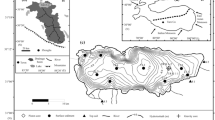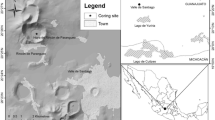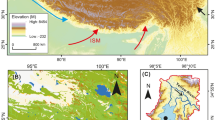Abstract
Sediments spanning the last 30000 yr BP were obtained from two sections in the southern part of the Tengger Desert, northwestern China (38°10′46″N, 102°45′53″E). The pollen assemblage suggested a Picea forest domination under a wetter and cooler environment from 27580 to 23510 yr BP. During the following period from 23510 to 21880 yr BP a Cyperaceae meadow occurred under a wet and cold climate. Wetter and cooler conditions returned and a Picea forest re-occupied this region between 21880 and 20910 yr BP. From 20910 to 15590 yr BP a steppe under a dry environment dominated the region. The first temperature increase started at ca.15590 yr BP. The pollen assemblage covering the period between 15590 and 10890 yr BP can be divided into six minor zones, suggesting that the vegetation compositions changed rapidly under unstable climate. Between 10710 and 10370 yr BP the climate became cold and dry again. The climatic conditions became warmer and more humid between 10260 and 9140 yr BP. From 8450 to 7950 yr BP a steppe landscape under a dry climate occupied this region. Between 7950 and 7290 yr BP climate seemed more humid. The following period from 7290 to 5670 yr BP was generally warm. The period between 5670 and 3510 yr BP was characterized by dramatic climatic oscillations. Relatively cold intervals appeared around 7760 and 7380, 6490—6290, 5670—5010, 4470—3510 yr BP. Two pronounced dry events occurred in 6290—5670 and 5010—4470 yr BP with a marked wet spell from 3510 to 3000 yr BP.
Similar content being viewed by others
References
Broecker, W. S., Future directions of paleoclimate research, Quaternary Science Reviews, 1997, 16: 821–825.
Pachur, H. J., Wunnemann, B., Zhang, H. C., Lake evolution in the Tengger Desert, Northwestern China, during the last 40,000 years, Quaternary Research, 1995, 44: 171–181.
Wunnemann, B., Pachur, H. J., Zhang, H. C., Climatic and environmental changes in the deserts of Inner Mongolia, China, since the Late Pleistocene, Quaternary Deserts and Climatic Change (eds. Alsharhan, A. S., Glenme, K. W., Whittle, G. L. et al.), Rotterdaman: Balkema, 1998, 381–394.
Zhang, H. C., Wunnemann, B., Preliminary study on the chronology of lacustrine deposits and determination of high paleolake level in Tengger desert since Late Pleistocene, Journal of Lanzhou University (in Chinese), 1997, 33(2): 87–91.
Zhang, H. C., Ma, Y. Z., Wunnemann, B. et al., A Holocene climatic record from arid northwestern China, Palaeogeography Palaoeclimatology Palaeoecology, 2000, 162: 389–401.
Ma, Y. Z., Zhang, H. C., Li, J. J. et al., On the evolution of the palynoflora and climatic environment during Late Pleistocene in Tengger Desert, Acta Botanica Sinica (in Chinese), 1998, 40(9): 871–879.
Chen, L., Qu, Y., Water and Land Resources and Their Rational Development and Utilization in the Hexi Region (in Chinese), Beijing: Science Press, China, 1992, 3–22.
Hou, X., Vegetation Geography of China and Chemical Composition of Certain Dominant Plants (in Chinese), Beijing: Science Press, 1982, 303–304.
Huang, D., Wang, W., Vegetation of Gansu (in Chinese), Lanzhou: Gansu Science and Technology Press, China, 1997, 79–183.
Wu, Z. Y., Vegetation of China (in Chinese), Beijing: Science Press, China, 1980, 82–120.
Huang, C. X., A study on pollen in surface soil from the western Tibet, And Land Geography (in Chinese), 1993, 16(4): 75–83.
Li, W. Y., Yao, Z. J., A study on the Quantitative relationship between Pinus pollen in surface sample and Pinus vegetation, Acta Botanica Sinica (in Chinese), 1990, 32(12): 943–950.
Wu, Y. S., Sun, X. J., A preliminary study on the relationship between the pollen percentages in forest surface samples and surrounding vegetation on west mountain of Kunming, Yunnan, Acta Botanica Sinica (in Chinese), 1987, 29(2): 204–211.
Xiu, Q. H., Yang, X. L., Wu, Z. et al., Alluvial pollen on the North China plain, Quaternary Research, 1996, 46: 270–280.
Yan, S., Xu, Y. Q., Spore-pollen association in surface-soil in Altay, Xinjiang. And Land Study (in Chinese), 1989, 1: 26–33.
Zhang, J. h., Kong, Z. C., Du, N. Q., Pollen analysis of surface samples from Baihua and Dongling mountains in Beijing, Marine Geology and Quaternary Geology (in Chinese), 1996, 16(3): 101–113.
Zhu, Y., Chen, F. H., Madsen, D., Environmental signal of an early Holocene pollen record from Shiyang River basin lake sediments, NW China, Chinese Science Bulletin, 2001, 47(4): 267–273.
Author information
Authors and Affiliations
Corresponding author
About this article
Cite this article
Ma, Y., Zhang, H., Pachur, H.J. et al. Late Glacial and Holocene vegetation history and paleoclimate of the Tengger Desert, northwestern China. Chin.Sci.Bull. 48, 1457–1463 (2003). https://doi.org/10.1360/02wd0274
Received:
Accepted:
Issue Date:
DOI: https://doi.org/10.1360/02wd0274




